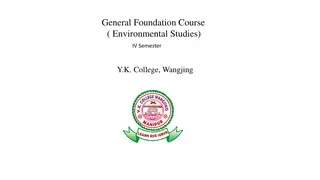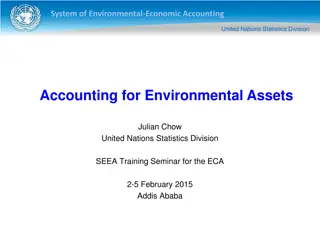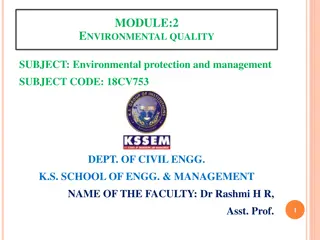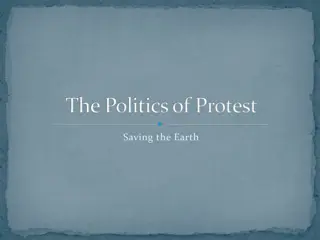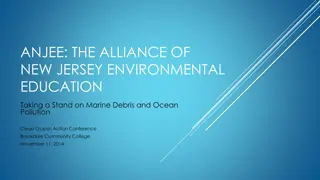Understanding Environmental Education: Concepts, Importance, and Scope
Environmental education is crucial in addressing the imbalance in nature caused by human activities. It aims to increase awareness about environmental issues, the impact of human actions, and effective ways to manage ecosystems. This introduction delves into the meaning and definition of environment, emphasizing the need for environmental education. It also explores the different types of environments and the core themes of environmental education.
Download Presentation

Please find below an Image/Link to download the presentation.
The content on the website is provided AS IS for your information and personal use only. It may not be sold, licensed, or shared on other websites without obtaining consent from the author. Download presentation by click this link. If you encounter any issues during the download, it is possible that the publisher has removed the file from their server.
E N D
Presentation Transcript
INTRODUCTION TO ENVIRONMENTAL EDUCATION Presented By, Mrs. Anuradha K, Assistant Professor of Bio-science, Jaya College of Education, Thiruninravur.
UNIT -1: ENVIRONMENTAL EDUCATION Concept and meaning of Environment-Focal aspects of Environmental Education- Goals and Objectives of Environmental Education-Need and Importance of Environmental Education-Core themes of Environmental Education-Scope of Environmental Education
INTRODUCTION OF ENVIRONMENTAL EDUCATION Due to man s interaction with nature on a large scale ,the balance of nature has been upset and environmental degradation has occurred in most parts of the world, because of environmental pollution, over exploitation of natural resources etc. It has posed a great danger threatening the existence of man, plants and animals on the earth. So there is a need to increase awareness and understanding of those environments and man s impact on them and find out the effective ways and means to manage them. To achieve the above goal, Environmental Education is the need of the day.
MEANING OF ENVIRONMENT A. Goudie(1984) in his book "The Nature of the Environment has taken environment as the representative of physical components of the earth wherein man is an important factor affecting the environment . Literary environment means the surrounding external conditions influencing development or growth of people, animal or plants; living or working conditions etc. This involves three questions: 1. What is Surrounded? ,- living beings in general and man in particular. 2. By what Surrounded ?-The physical attributes 3. Where Surrounded?-The space or habitat.
DEFINITION OF ENVIRONMENT A person s environment consists of the sum total of the stimulation which he receives from his conception until his death. -Boring The term environment is used to describe, in the aggregate, all the external forces, influences and conditions, which affect the life, nature, behaviour and the growth, development and maturity of living organisms. -Douglas and Holland Environment is an external force which influences us. -E.J.Ross
TYPES OF ENVIRONMENT There are four types of environment such as Natural Environment Man made Environment Social Environment Psychological Environment
NATURAL ENVIRONMENT The natural environment encompasses all living and non-living things occurring naturally. Natural environment operates through self regulating mechanism i.e., any change in natural ecosystem brought about by natural process is counter balanced by changes in the other component of the environment. This mechanism is known as homeostatic environment. Thus, there exists a reciprocal relationship among various components of the environment. These components are water, air, noise, soil, forest, wild life, flora and fauna etc.
CLASSIFICATION OF NATURAL ENVIRONMENT The Natural environment is classified into Biotic or living component Abiotic or Physical component
BIOTIC COMPONENTS The living components of an ecosystem are called the biotic components. The biotic components are classified into Flora- It consists of plants, grass, bushes, forests etc which do not have the ability to move . Fauna- It consists of animals, birds, reptiles, etc. These organisms have the ability to move from place to place. Micro organisms- It consists of bacteria, virus, algae, fungi and protozoa.
ABIOTIC COMPONENTS Abiotic factors refer to all the non-living chemical and physical factors present in the atmosphere, hydrosphere, and lithosphere. Sunlight, air, precipitation, minerals, and soil are some examples of abiotic factors. These factors have a significant impact on the survival and reproduction of species in an ecosystem. Abiotic components consists of Lithosphere Hydrosphere Atmosphere
LITHOSPHERE This means the mantle of rocks constituting the earth s crust. The earth is a cold spherical solid planet of the solar system, which spins in its axis and revolves around the sun at a certain constant distance. Lithosphere mainly, contains soil, earth rocks, mountain etc. Lithosphere is divided into three layers-crusts, mantle and core (outer and inner
HYDROSPHERE It refers to water in its various forms. It includes all types of water resources such as oceans, seas, rivers, lakes, streams, reservoirs, glaciers, polar ice caps and ground water (i.e. water below the earth s surface). About 97% of the earth s water supply is in the oceans while the high salt content does not allow its use for any human consumption. About 2% of the water resource gets locked in the polar ice caps and glaciers, while only 1% is found as fresh water (surface water-river, lakes, streams and ground water) for human consumption and other uses. Hydrosphere functions in a cyclic nature, which is termed as hydrological cycle or water cycle.
ATMOSPHERE The cover of the air, that envelopes the earth is known as the atmosphere. It is a thin layer which contains gases like oxygen, carbon dioxide etc. and protects the earth from the harmful radiations of the sun. There are five concentric layers within the atmosphere, which can be differentiated on the basis of temperature, each having its own characteristics. These include Troposphere Stratosphere Mesosphere Thermosphere Exosphere
TROPOSPHERE This is the lowest part of the atmosphere - the part we live in. It contains most of our weather - clouds, rain, snow. In this part of the atmosphere the temperature gets colder as the distance above the earth increases. The troposphere contains about 75% of all of the air in the atmosphere, and almost all of the water vapour (which forms clouds and rain). The decrease in temperature with height is a result of the decreasing pressure.
STRATOSPHERE This extends upwards from the tropopause to about 50 km. It contains much of the ozone in the atmosphere. The increase in temperature with height occurs because of absorption of ultraviolet (UV) radiation from the sun by this ozone. Temperatures in the stratosphere are highest over the summer pole, and lowest over the winter pole. By absorbing dangerous UV radiation, the ozone in the stratosphere protects us from skin cancer and other health damage. However chemicals (called CFCs or freons, and halons) which were once used in refrigerators, spray cans and fire extinguishers have reduced the amount of ozone in the stratosphere, particularly at polar latitudes, leading to the so-called "Antarctic ozone hole
MESOSPHERE Above the stratosphere is the mesosphere. It extends upward to a height of about 85 km (53 miles) above the surface of the earth. . Most meteors burn up in the mesosphere. Unlike the stratosphere, temperatures once again grow colder as you rise up through the mesosphere. The coldest temperatures in Earth's atmosphere, about -90 C (-130 F), are found near the top of this layer. The air in the mesosphere is far too thin to breathe; air pressure at the bottom of the layer is well below 1% of the pressure at sea level, and continues dropping as you go higher.
THERMOSPHERE The layer of very rare air above the mesosphere is called the thermosphere. High- energy X-rays and UV radiation from the Sun are absorbed in the thermosphere, raising its temperature to hundreds or at times thousands of degrees. However, the air in this layer is so thin that it would feel freezing cold to us! In many ways, the thermosphere is more like outer space than a part of the atmosphere. Many satellites actually orbit Earth within the thermosphere. Variations in the amount of energy coming from the Sun exert a powerful influence on both the height of the top of this layer and the temperature within it.
EXOSPHERE The exosphere to be the actual "final frontier" of Earth's gaseous envelope lying at 400 to 20,000km of height from the surface of the earth where temperature ranges from 1000*c to 10,000*c. The air in the exosphere is very, very, very thin, making this layer even more space-like than the thermosphere. In fact, air in the exosphere is constantly - though very gradually - "leaking" out of Earth's atmosphere into outer space. There is no clear-cut upper boundary where the exosphere finally fades away into space.
BIOSPHERE Biosphere is otherwise known as the life layer, it refers to all organisms on the earth s surface and their interaction with water and air. It consists of plants, animals and micro-organisms, ranging from the tiniest microscopic organism to the largest whales in the sea. Biology is concerned with millions of species of animals, plants and other organisms. They grow, feed, move, reproduce and evolve over long periods of time in different environments. Its subject matter is useful to other sciences and professions that deal with life, such as agriculture, forestry and medicine. The richness of biosphere depends upon a number of factors like rainfall, temperature, geographical reference etc.
MAN MADE ENVIRONMENT This refers to the artificial environment created by man.Man is using advanced technologies to create an environment suited to him. Man is the potent agent of environmental intervention. Man is able to expand transport facilities, build dams, extend irrigational areas, improved housing facilities, producing and using nuclear, hydroelectric and thermal power etc.
SOCIAL ENVIRONMENT Social Environment includes an individual s social, economic and political condition wherein he lives. The moral, cultural and emotional forces influence the life and nature of individual behavior. Society may be classified into two categories as under: (i) An open society is very conductive for the individual development. (ii)A closed society is not very conductive for the development.
PSYCHOLOGICAL ENVIRONMENT Every individual has his own psychological environment, in which he lives. Kurt Lewin has used the term life space for explaining psychological environment. The Psychological environment enables us to understand the personality of an individual. Both the person and his goal form psychological environment. If a person is unable to overcome the barriers, he can either get frustrated or completed to change his goal for a new psychological environment. But adopting this mechanism, the individual is helped in his adjustment to the environment.






